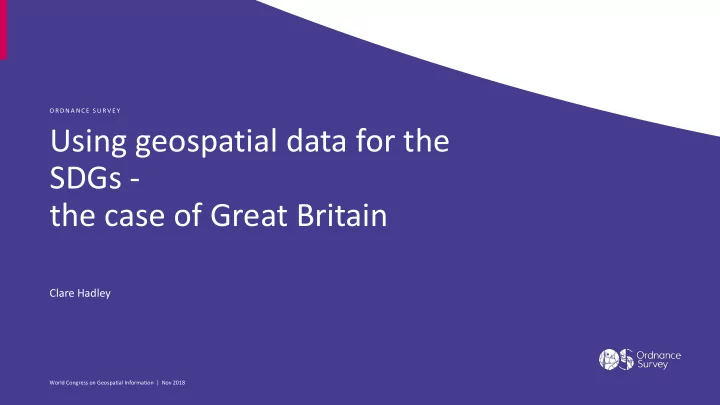

O R D N A N C E S U R V E Y Using geospatial data for the SDGs - the case of Great Britain Clare Hadley World Congress on Geospatial Information | Nov 2018
Outline Who are we? • Ordnance Survey (OS) and the Office for National Statistics (ONS) What have we done? • Urban natural capital accounting • Indicator 9.1.1. Access to all season road • Indicator 11.3.1 Ratio of land consumption rate to population growth rate What have we learnt? World Congress on Geospatial Information | Nov 2018
Ordnance Survey World Congress on Geospatial Information | Nov 2018
Great Britain’s national mapping agency Create geospatial data Support government International expertise Innovation Our data is trusted to support policy and We produce location data at levels of We take our expertise and capability to We support research and innovation the delivery of public services at every detail and accuracy not created support sustainable development and with our Geovation Hub which supports level of government geospatial entrepreneurs . anywhere else, using ground based deliver efficient public services. survey and remote imaging World Congress on Geospatial Information | Nov 2018
Office for National Statistics World Congress on Geospatial Information | Nov 2018
UK’s largest independent producer of official statistics and its recognised national statistical institute Responsibilities COLLECTING ANALYSING DISSEMINATING Geospatial is key to all of these core functions EFFICIENT CAPABLE HELPFUL PROFESSIONAL INNOVATIVE
Urban Natural Capital Accounting World Congress on Geospatial Information | Nov 2018
Case Study – Urban Natural Capital Accounting • At the start of 2018 the UK government published a 25 Year Environment Plan setting out how we will improve the environment. • Aligned to the SDGs • Part of this was the production of a full set of 'natural capital accounts' for the UK to help monitor progress. • OS and ONS worked together on this to produce statistics for urban areas • Extent Account - describes the area and number of green and blue spaces in all urban areas. • Services Account - examines the relationship between residential property price and urban green and blue space. World Congress on Geospatial Information | Nov 2018
Key Findings Case Study – Urban Natural Capital Accounting • Approximately 530 thousand hectares of residential garden and 550 thousand hectares of non-residential natural land cover exists in urban areas in Great Britain, accounting for 30% and 31% of the total urban area respectively. • The built-up area with the largest proportion of urban natural land cover is West Yorkshire (in the NE of England), 46% of the urban area consists of natural land cover. Brighton and Hove (on the South Coast) have the smallest proportion of natural land cover (20%). • Very large areas of functional green space and blue space within 200m have the largest positive impact on property prices, resulting in an increase of 1.4% and 3.6% respectively. World Congress on Geospatial Information | Nov 2018
Indicator 9.1.1 Proportion of the rural population who live within 2 km of an all-season road World Congress on Geospatial Information | Nov 2018
World Congress on Geospatial Information | Nov 2018
Indicator 11.3.1 Ratio of land consumption rate to population growth rate World Congress on Geospatial Information | Nov 2018
Process Overview Pre-process LSOA geographies, taking care of multiple islands situated within a single LSOA, and oversized rural LSOA’s Cluster Topographic Areas from 2013 and 2016 with each LSOA, working out intersection areas from overlapping polygons Calculate areas of each land cover type by LSOA, and group the results accordingly Join the two snapshot areas, accounting for land cover types present in one snapshot that aren’t in the other Output as a spreadsheet, with percentage area cover for each snapshot, enabling land area composition changes to be calculated World Congress on Geospatial Information | Nov 2018
Key findings • In Great Britain, land consumption grew faster than the population growth rate. • Across GB land consumption grew by 4.3% and the population by 1.5%. • In England, land consumption grew faster than the population, • In Wales the population grew faster than the land consumption rate. • In Scotland land consumption rate versus the population growth rate was the highest . World Congress on Geospatial Information | Nov 2018
Lessons learnt World Congress on Geospatial Information | Nov 2018
Lessons learnt • Geospatial data can be successfully used with statistical data to provide information for policy makers, and also to enable the measurement and monitoring of the SDGs • Pilots and tests of the data are useful ways to explore what information can be derived from it • Further work is needed to find scalable methods and suitable sources of data World Congress on Geospatial Information | Nov 2018
Thank You! Clare Hadley Head of Stakeholder Engagement www.OrdnanceSurvey.co.uk Clare.Hadley@os.uk +44 23 80 05 56 12 @Chadley_OS World Congress on Geospatial Information | Nov 2018
Recommend
More recommend